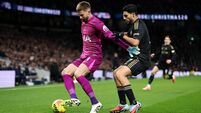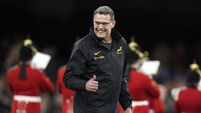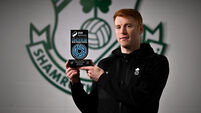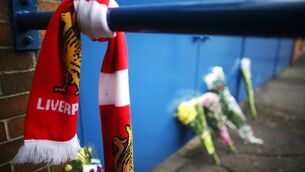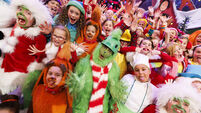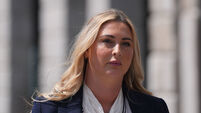Michael Moynihan: Examining the tale of Christy Ring

Not sure if you picked up on this, but last week was the centenary of Michael O’Hehir’s birth.
The sports commentator didn’t dominate Irish life for decades so much as embody its summers almost single-handedly. The radio wheezed with a brief spatter of welcome in Irish, then the wash of white noise in the background, a crowd roaring in stereo.
If you are of a certain age - and your columnist certainly is - then you can probably recall beach scenes in Julys and Augusts long ago, when cars parked near the sand spilled O’Hehir’s match commentaries out into the sun, funnelled through a radio set in a scorching dashboard.
If you timed your walk along the summer beachfront properly, you could get all the action from Thurles or Limerick or Croke Park as you passed those open car windows, picking up the commentary as you hunted for a Choc Ice.
One of the men O’Hehir immortalised in that nasal delivery came into the world the same year: Christy Ring was also born in 1920, and many of the Cork icon’s achievements were delivered via RTÉ radio and his contemporary.
Confession: your columnist has an ulterior motive for reminding readers of Ring this morning. A couple of years ago I was involved in the making of documentary series The Game: The Story of Hurling, and as part of that process we gathered some material and travelled some byways that didn’t always fit into the main narrative.
One of the more surprising discoveries was Ring’s standing among even contemporary hurlers - plaudits from Donal O’Grady of this parish, who had seen Ring in action, were no shock, but Tommy Walsh of Kilkenny waxing lyrical about someone who first came to prominence in the late thirties as a precocious minor?
It shouldn’t have been surprising, of course. In the modern parlance Ring was always someone who generated plenty of content.
His play sparked argument and debate, discussion and analysis that rattled on for decades. On championship Sundays the pubs and hotels ribboning the roads from Cork to Thurles and Limerick buzzed with chat of Ring’s potential influence on events before a game; on the return journey his impact on events the travellers had just witnessed was puzzled over and replayed, again and again.
That was the immediate afterglow, the direct consequence of action: the goals and points, the flourishes of skill and courage. Ring lived as vividly in the putdowns and one-liners which spun off the events themselves (“We’ll have to shoot you,” said Mickey Byrne of Tipperary to Ring after one robust encounter. “Why not,” said Ring, “You’ve tried everything else.”)
It was no surprise that we ended up closing off the hurling series with Ger Loughnane’s delivery of Ring’s classic line: “Let no-one say the best hurlers belong to the past. They are with us now and better yet to come.”
With all of that in mind the same team that produced The Game is saddling up to make a documentary about the Master himself, and the response from those supporting the project has already been gratifying.
What we’re keen on, however, is to leave no stone unturned, which is why I attach below the email address for the project. If you or anyone you know has audio or video footage of Christy Ring in action don’t be shy about getting in touch.
Are we wrong to hope someone - in Ireland, America, somewhere - has a can of film that might add to the canon? We’d like to err on the side of caution.
Awkward Questions Need Awkward Answers
Nobody likes a . . . spoilsport, but is everyone certain about this return to sporting action?
(Note: I like the way roadmap is the widely-used term for this return, particularly as I associate the formulation with efforts to solve long-festering enmity in the Middle East.)
I appreciate the curve has been flattened successfully, which is the absolute outer boundary marker of my epidemiological knowledge, but if social distancing is still being encouraged now, how are Gaelic games set to return in a couple of weeks?
I pick Gaelic games because of the voluntary aspect: it’s instructive to see the Bundesliga stage games and to see the NBA devising elaborate plans to ensure its season can resume, but those are professional sports with vast resources when it comes to isolation and testing.
Not so with Gaelic games - and yes, junior soccer and rugby, hockey and basketball, the vast majority of sports here in Ireland.
There are any number of questions which you can expect to see raised in the next three weeks. Not just questions about how questions are asked, either (though here’s an example from that genre: how can economic necessity be a viable argument for opening up now if remaining open for economic reasons wasn’t viable when the lockdown began?)
I don’t mean questions that undermine the national myth either, by which I mean the pointed inquiries you can expect about the conditioning of certain sportspeople, or their whereabouts at the times usually devoted to training.
The questions I expect to hear are those from players who are unsure whether they want to play in the first place.
I noted the Taoiseach’s reference to a low-risk, not a no-risk, scenario some time ago: what happens if a player has a parent or child with an underlying condition or is working in the health service? If the player lives in a small, close-knit community and is concerned about the possibility of bringing the virus into that community?
What happens if a player raises those kinds of legitimate questions?
Extraordinary times Stateside
The NBA was one of the fastest sports to shut down when the virus began to spread, but now it’s on schedule to restart in Walt Disney World in Florida next month (no jokes, please.)
Reports last week suggested the NBA is facing a deficit of $1 billion if it didn’t resume play.
As a measure of how extraordinary the times are, that probably wasn’t the biggest sports story in the States last week. Consider the violence that’s erupted since the killing of George Floyd, and the demonstrations that have echoed across the globe.
Sport is a strong connective thread in the reaction to Floyd’s death. Many demonstrators in the States have knelt, for instance, mirroring American football star Colin Kaepernick’s famous protests, and the NFL itself has now apologised for not listening to black players’ concerns about race (without naming Kaepernick, mind you).
Extraordinary doesn’t quite cover it.
Invisible Yet Enduring Lilacs
One of the lesser sins of the lockdown has been a delay in arrival when it comes to certain items. I’d only come across Gerald Murnane, the Australian writer, at a remove, but the notices for his memoir, Invisible Yet Enduring Lilacs, seemed good, particularly his strong interest in horseracing.
Credit to And Other Stories, his publisher in the UK, for performing heroics in getting the memoir out to me. So far so hypnotising prose, almost mirroring - for me, anyway - the warping, immersive heat of Bendigo and other areas mentioned.
Many thanks to Nichola Smalley for providing me with the book - and a bonus accompaniment, Murnane’s Collected Shorter Fiction. Next on the list.
